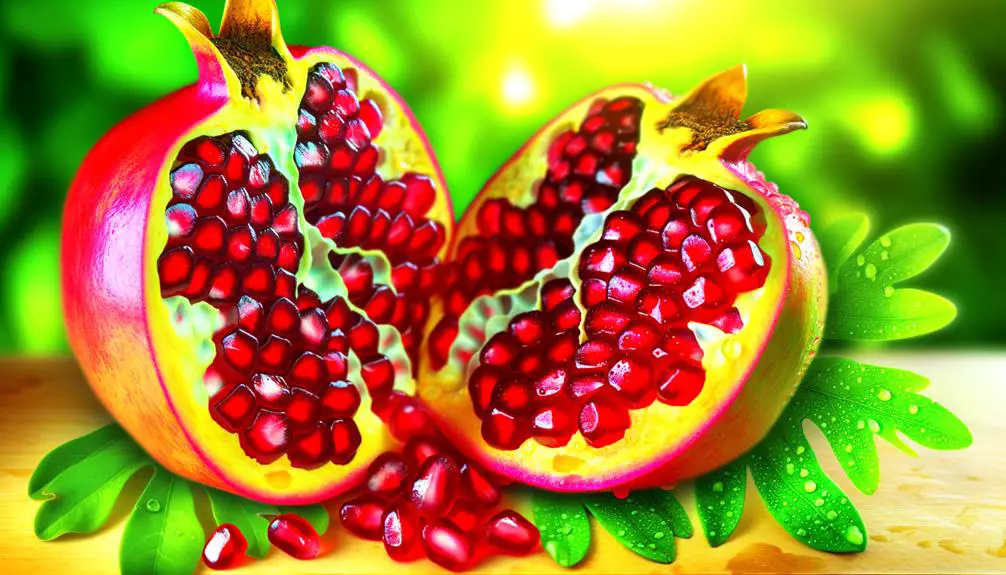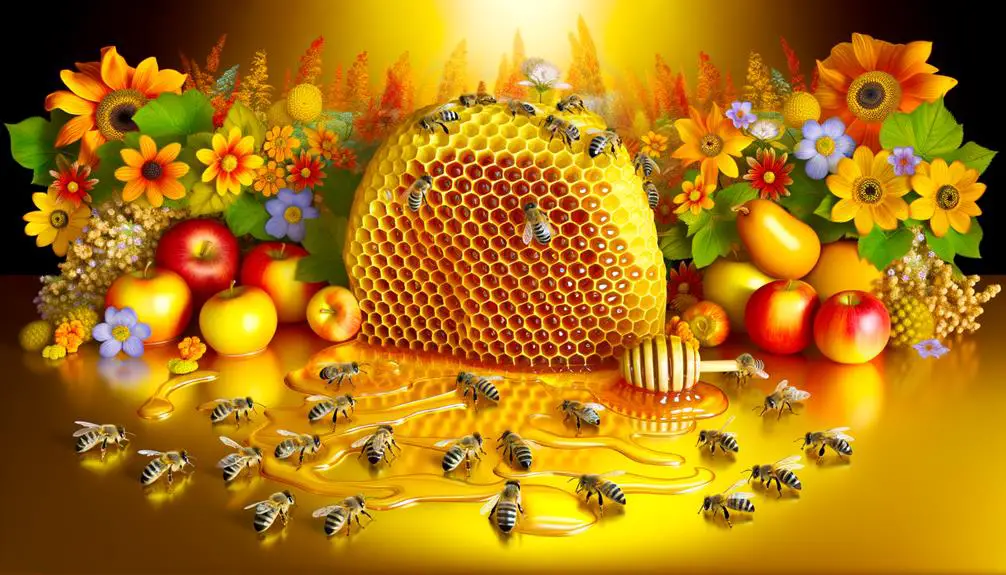Using Symbols of Abundance and Nourishment in Home Decor
Symbols of abundance and nourishment encapsulate prosperity and health, reflected through various cultural emblems. The cornucopia, originating from Greek mythology, is a horn-shaped vessel overflowing with produce.
Wheat, essential for a balanced diet, symbolizes agricultural prosperity. Pomegranates are revered for their fertility-enhancing properties.
Fish represent economic stability and nutritional abundance. Grapes, often associated with joy and festivity, provide crucial antioxidants.
Rice, fundamental to numerous cultures, underpins both dietary and economic sustenance. Honey, with its rich nutrients and healing properties, contributes to overall well-being.
Explore the nuances behind these symbols to enrich your understanding of their significance.

Key Takeaways
- The cornucopia symbolizes abundance and nourishment, originating from ancient Greek mythology and often depicted as overflowing with produce.
- Wheat, a cornerstone of agriculture with a rich nutritional profile, represents prosperity and essential nourishment.
- Pomegranates, rich in antioxidants and vitamins, symbolize fertility and wealth in various cultures.
- Fish, rich in omega-3 fatty acids and proteins, are symbols of abundance and prosperity in many traditions.
- Grapes are symbols of joy and festivity, often present at gatherings to signify prosperity and well-being.
Cornucopia: The Horn of Plenty

The cornucopia, often referred to as the 'Horn of Plenty,' is an enduring symbol of abundance and nourishment that dates back to ancient Greek mythology. Traditionally, it is depicted as a large, horn-shaped container overflowing with an assortment of produce, flowers, and nuts.
According to myth, the cornucopia originated from the horn of the goat Amalthea, which provided Zeus with endless sustenance. This symbol has transcended time to represent prosperity and the bountiful harvests fundamental to human survival.
In modern contexts, cornucopias are frequently used in Thanksgiving decorations, symbolizing gratitude and plenty. Understanding its historical roots enhances appreciation for its continued relevance in contemporary celebrations of abundance and nourishment.
Wheat: A Staple of Prosperity
Wheat has long been a cornerstone of agricultural development, providing sustenance and economic stability throughout history.
Its nutritional profile, rich in necessary vitamins and minerals, underscores its role as an important food source.
Examining wheat's historical significance and its health benefits highlights its significance as a symbol of prosperity and nourishment.
Historical Significance of Wheat
Throughout history, wheat has been revered as a fundamental pillar of human civilization, driving agricultural development and economic stability. Originating in the Fertile Crescent around 10,000 BCE, wheat cultivation enabled the rise of settled societies. Its adaptability to diverse climates facilitated widespread cultivation, supporting population growth and urbanization. The Roman Empire's grain trade exemplified wheat's central role in maintaining political power and societal order.
| Era | Significance | Example |
|---|---|---|
| Neolithic | Agricultural Revolution | Fertile Crescent farming |
| Classical | Economic and political stability | Roman grain trade |
| Medieval | Feudal economies and sustenance | European crop rotations |
Wheat's historical trajectory underscores its indispensable role in shaping civilizations, reinforcing its status as a symbol of abundance and nourishment.
Nutritional Benefits of Wheat
Rich in essential nutrients and dietary fiber, wheat provides a robust foundation for a balanced diet, promoting overall health and well-being. This versatile grain is a significant source of complex carbohydrates, which are vital for sustained energy release.
Whole wheat is particularly nutrient-dense, offering high levels of vitamins B and E, iron, magnesium, and antioxidants. Dietary fiber in wheat aids digestion, regulates blood sugar levels, and can lower the risk of heart disease.
Consuming wheat-based foods like whole grain bread, pasta, and cereals can contribute to daily nutrient requirements. For those seeking to improve their diet, incorporating whole wheat products is a practical and advantageous choice, enhancing both nutritional intake and general health.
Pomegranates: Seeds of Fertility

Pomegranates, with their jewel-like seeds, have long been revered as potent symbols of fertility and wealth in various cultures. Historically referenced in ancient texts and art, pomegranates are often associated with prosperity and the cyclical nature of life.
Scientifically, this fruit is rich in antioxidants, vitamins C and K, and folate, all of which contribute to reproductive health. Consuming pomegranates can support a healthy pregnancy by enhancing blood flow and reducing oxidative stress.
Research also suggests that the phytoestrogens in pomegranates may help balance hormones, further promoting fertility. For those seeking natural ways to boost fertility, integrating pomegranates into the diet is both a nutritious and culturally resonant practice.
Fish: A Sign of Abundance
In many cultures, fish are esteemed as symbols of abundance and prosperity, often featured in art, literature, and culinary traditions to signify wealth and sustenance. Historically, societies near water sources thrived due to the plentiful fish, which provided essential nutrients and economic stability.
For instance, in Chinese culture, fish symbolize prosperity and are integral to celebratory meals like the Lunar New Year. The biblical story of the loaves and fishes further underscores fish as a metaphor for divine provision.
Nutritional studies affirm fish's role in a balanced diet, rich in omega-3 fatty acids and proteins. Consequently, fish not only represent abundance culturally but also offer practical health benefits, reinforcing their status as symbols of nourishment and prosperity.
Grapes: Symbols of Joy

Grapes have long been celebrated as symbols of joy and festivity in various cultural traditions. Their presence at gatherings signifies prosperity and communal happiness. Historically, grapes have been used in rituals and ceremonies to mark joyous occasions. Nutritionally, they are a rich source of vitamins C and K, essential for maintaining immune function and bone health.
| Benefit | Nutritional Value |
|---|---|
| Vitamins | C, K |
| Antioxidants | Flavonoids, Resveratrol |
| Calories | 70 per cup |
Incorporating grapes into one's diet can enhance overall well-being, given their antioxidant properties which combat oxidative stress. Practical advice for consumption includes adding them to salads, desserts, or enjoying them fresh. This not only boosts nutrient intake but also aligns with cultural practices celebrating joy and abundance.
Bread: The Essence of Life
While grapes symbolize joy and festivity, bread stands as a universal emblem of sustenance and life across numerous cultures.
Historically, bread has been a staple in the human diet, providing essential nutrients such as carbohydrates, fiber, and various vitamins. Archaeological evidence indicates that humans have been baking bread for over 14,000 years.
Its role in religious rituals, from Christian Eucharist to Jewish Shabbat, underscores its cultural significance. Modern nutritional science supports the consumption of whole-grain bread for its health benefits, including improved digestion and reduced risks of chronic diseases.
Bread's simplicity and versatility make it a practical and enduring symbol of nourishment, bridging historical and contemporary dietary practices.
Olive Branch: Peace and Plenty

Renowned for its historical and cultural symbolism, the olive branch represents both peace and abundance across various civilizations. This emblematic plant has been referenced throughout history, from ancient Greek mythology to modern diplomatic gestures.
Evidence-based analysis reveals its significance:
- Peace Treaties:
The olive branch has been used in peace treaties, symbolizing an end to conflict.
- Economic Value:
Olive oil, derived from the olive tree, has been a staple in Mediterranean economies, signifying prosperity.
- Cultural Rituals:
In various cultures, olive branches are used in ceremonies to bless homes and communities, promoting harmony and goodwill.
For those seeking to understand its importance, the olive branch epitomizes a rich blend of peace, economic stability, and cultural heritage.
Rice: Nourishment and Growth
Rice has been a cornerstone of human civilization, playing an essential role in the historical development of numerous cultures. Its nutritional profile, rich in necessary carbohydrates, vitamins, and minerals, contributes greatly to global food security and individual health.
Understanding the historical importance and nutritional benefits of rice underscores its significance as a symbol of both nourishment and growth.
Historical Significance of Rice
Throughout history, rice has played a pivotal role in the sustenance and economic development of numerous civilizations. Its significance can be observed through various aspects:
- Agricultural Foundation: Rice cultivation dates back over 10,000 years, forming the backbone of agrarian societies in Asia and beyond. Archaeological evidence from China and India underscores its ancient roots and widespread cultivation.
- Economic Driver: Rice trade has historically been an essential economic activity. During the colonial period, rice was a major export commodity, driving trade in regions like Southeast Asia and West Africa.
- Cultural Impact: Beyond sustenance, rice holds cultural significance, featuring prominently in religious rituals, festivals, and social customs, symbolizing prosperity and life in many cultures.
These elements illustrate rice's enduring historical importance.
Nutritional Benefits of Rice
A cornerstone of global diets, rice provides essential nutrients that support bodily growth and overall health. Rich in carbohydrates, rice serves as a primary energy source, particularly valuable for physically active individuals. It also contains important vitamins and minerals such as B vitamins, phosphorus, and magnesium, which play vital roles in energy metabolism, bone health, and cellular function.
Brown rice, in particular, offers additional fiber, aiding in digestive health and promoting a feeling of fullness. Moreover, rice is low in fat and cholesterol, making it a heart-healthy option. For those with gluten sensitivities, rice is a safe, gluten-free grain that can be easily incorporated into diverse culinary traditions, ensuring both variety and balance in the diet.
Honey: Sweetness and Wealth

Renowned for its dual role as both a natural sweetener and a symbol of prosperity, honey has been treasured across cultures for its nutritional and economic value. As a versatile food, honey offers numerous benefits:
- Nutritional Content: Packed with antioxidants, vitamins, and minerals, honey supports overall health and wellness.
- Economic Importance: Honey production significantly contributes to the livelihoods of beekeepers and rural economies worldwide.
- Culinary Uses: Its unique flavor profiles enhance a variety of dishes, from desserts to savory meals.
Evidence indicates honey's antimicrobial properties can aid in wound healing and its natural sugars provide a healthier alternative to refined sugar. Understanding these multifaceted benefits underscores honey's enduring status as a symbol of both sweetness and wealth.
Conclusion
To wrap up, the symbols of abundance and nourishment—ranging from the cornucopia to honey—each carry profound cultural and historical significance. These elements not only represent physical sustenance but also embody ideals of prosperity, fertility, and joy.
Just as wheat stands as a staple of prosperity and the olive branch signifies peace and plenty, these symbols collectively illuminate a deeper understanding of human civilization's values.
Consequently, studying these symbols enriches the appreciation of both tangible and intangible aspects of human culture.






